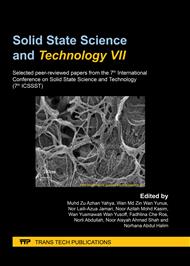[1]
L. Biasetto, Functional Ceramic Foam from Preceramic Polymers. Universita di Bologna: Doctor of Philosophy Thesis, (2006).
Google Scholar
[2]
F. Viganò, C. Cristiani, M. Annoni, Ceramic sponge Abrasive Waterjet (AWJ) precision cutting through a temporary filling procedure, Journal of Manufacturing Processes 28 (2017) 41–49.
DOI: 10.1016/j.jmapro.2017.05.014
Google Scholar
[3]
A. Studart, U. Gonzenbach, E. Tervoort, L. Gauckler, Processing Routes to Macroporous Ceramics: A Review, Journal of the American Ceramic Society 89 (2006) 1771–1789.
DOI: 10.1111/j.1551-2916.2006.01044.x
Google Scholar
[4]
O. Lyckfeldt, J.M.F. Ferreira, Processing of Porous Ceramics by Starch Consolidation,, Journal of the European Ceramic Society 18 (1998) 131–140.
DOI: 10.1016/s0955-2219(97)00101-5
Google Scholar
[5]
Z. Hou, C. Liu, L. Liu, S. Zhang, Microstructural evolution and densification behavior of porous kaolin-based mullite ceramic added with MoO3, Ceramics International 44 (2018) 17914–17918.
DOI: 10.1016/j.ceramint.2018.06.266
Google Scholar
[6]
E. Gregorova, W. Pabst, Z. Zivcova, I. Sedlarova, S. Holikova, Porous Alumina Ceramics prepared with wheat flour, Journal of the European Ceramic Society 30 (2010) 2871–2880.
DOI: 10.1016/j.jeurceramsoc.2010.03.020
Google Scholar
[7]
E. Gregorová, W. Pabst, Porosity and pore size control in starch consolidation casting of oxide ceramics-Achievements and problems, Journal of the European Ceramic Society 27 (2007) 669–672.
DOI: 10.1016/j.jeurceramsoc.2006.04.048
Google Scholar
[8]
G. Xu, Z. Chen, X. Zhang, H. Cui, Z. Zhang, X. Zhan, Preparation porous Al2TiO5-Mullite ceramic by starch consolidation casting and its corrosion resistance characterization, Ceramics International 42 (2016) 14107–14112.
DOI: 10.1016/j.ceramint.2016.06.024
Google Scholar
[9]
T. Liu, C. Lin, P. Liu, J. Liu, C. Li, L. Han, A. Lu, Preparation and characterization of partially vitrified ceramic material, Journal of Non-Crystalline Solids 505 (2018) 92–101.
DOI: 10.1016/j.jnoncrysol.2018.10.019
Google Scholar
[10]
T.T. Dele-Afolabi, M.A.A. Hanim, Y. Bai, M. Norkhairunnisa, S. Sobri, R. Calin, Research trend in the development of microporous ceramic components by pore forming additives from natural organic matters: A short review, Ceramics International 10 (2016) 177.
DOI: 10.1016/j.ceramint.2016.10.177
Google Scholar
[11]
R. A. Chumnanklang, A. Jaroenworaluck, T. Panyathanmaporn, S. Supothina, Microstructure of kaolin spheres produced by a gel-casting process with a biopolymer additive, Surface and Interface Analysis 38 (2006) 539–543.
DOI: 10.1002/sia.2311
Google Scholar
[12]
A.N. Chen, M. Li, J. Xu, C.H. Lou, J.M. Wu, L.J. Cheng, C.H. Li, High-porosity mullite ceramic foams prepared by selective laser sintering using fly ash hollow spheres as raw materials, Journal of the European Ceramic Society 38 (2018) 4553–4559.
DOI: 10.1016/j.jeurceramsoc.2018.05.031
Google Scholar
[13]
R.M. Khattab, M.M.S. Wahsh, N.M Khalil, Preparation and characterization of porous alumina ceramics through starch consolidation casting technique, Ceramics International 38 (2012) 4723-4728.
DOI: 10.1016/j.ceramint.2012.02.057
Google Scholar
[14]
A. Hadi, R. Emadi, S.Baghshahi, S.H. Naghavi, Different pore size alumina foams and study of their mechanical properties, Ceramics - Silikaty 59 (2015) 6-9.
Google Scholar


